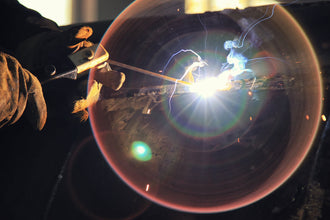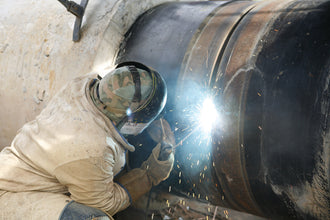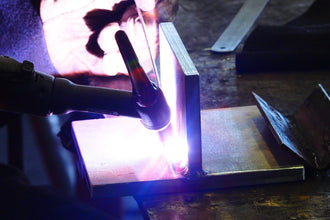
In the precise world of metal fabrication, the focus often lands on the welder's skill, the machine's power, or the electrode's quality. Yet, there is one silent, invisible component that is absolutely critical to achieving a strong, clean, and structurally sound weld: the shielding gas. Choosing the right gas for welding different metals is not a matter of guesswork; it is a fundamental decision that dictates the entire outcome of your project. An incorrect choice can lead to a host of problems, including porosity, excessive spatter, poor penetration, and even weld failure.
This definitive guide is designed to demystify the process of how to choose the right gas for welding different metals. We will delve deep into the science behind shielding gases, explore the specific requirements of the most common metals, and provide you with a clear, actionable framework for making the best decision every time you strike an arc. Whether you are a seasoned professional looking to optimize your process or a dedicated hobbyist aiming to elevate your craft, understanding how to choose the right gas for welding different metals is the key to unlocking superior weld quality.

Understanding the Fundamental Role of Shielding Gas in Welding
Before we can effectively address how to choose the right gas for welding different metals, we must first establish a firm understanding of why we use gas in processes like MIG (GMAW) and TIG (GTAW) welding.
The Battle Against Atmospheric Contamination
At its core, arc welding involves creating a molten puddle of metal. This puddle is incredibly reactive and, when exposed to the surrounding air, will readily interact with oxygen and nitrogen. These interactions have devastating consequences:
-
Oxygen (O2): Causes oxidation, which leads to brittleness, reduced corrosion resistance, and a weakened weld. It can also create porosity (tiny holes) and excessive, difficult-to-remove spatter.
-
Nitrogen (N2): Nitrogen absorption from the air results in severe porosity, a significant loss of ductility, and a dramatic decrease in the weld's impact strength.
The primary function of shielding gas is to create an inert or semi-inert blanket around the arc and the weld pool, effectively displacing the atmospheric air and preventing these detrimental reactions. The gas flows from the welding torch nozzle, enveloping the entire operation in a protective cloud.
Key Properties of Shielding Gases That Influence Your Weld
Not all gases behave the same way. When learning how to choose the right gas for welding different metals, you must consider three key properties of the gas:
-
Thermal Conductivity: This affects how heat is transferred from the arc to the workpiece. Gases with high thermal conductivity (like Helium) produce a wider, hotter arc and deeper penetration.
-
Ionization Potential: This is the energy required to create the arc plasma. Gases with high ionization potential (again, like Helium) require higher arc voltages to initiate and maintain a stable arc, resulting in more heat input.
-
Density: Heavier gases (like Argon) provide better coverage at lower flow rates, as they blanket the weld zone effectively. Lighter gases (like Helium) require higher flow rates to achieve the same level of protection.
Understanding these properties allows you to "tune" your welding process, a critical aspect of knowing how to choose the right gas for welding different metals.
A Deep Dive into Common Shielding Gases and Their Mixtures
Very few welding applications use a single, pure gas (with the notable exception of pure Argon for TIG welding). The art of how to choose the right gas for welding different metals often involves selecting the perfect blend or mixture. Let's examine the most common players.
The Inert Foundation: Argon and Helium
Argon (Ar)
Argon is the workhorse of the shielding gas world. It is inert, meaning it does not react with the weld pool, and it is heavier than air, providing excellent coverage.
-
Characteristics: Produces a smooth, stable, and easily controlled arc. It has a low ionization potential, which allows for easy arc starts and a concentrated arc column, leading to deep, narrow penetration. It is also excellent for cleaning action on materials like aluminum when using AC TIG welding.
-
Best For: TIG welding all metals, MIG welding non-ferrous metals (Aluminum, Copper, Magnesium), and as a base gas for mixtures used on carbon and stainless steels.
Helium (He)
Helium is also an inert gas but behaves very differently from Argon. It is much lighter than air.
-
Characteristics: Produces a hotter, wider arc due to its high thermal conductivity and ionization potential. This results in broader penetration profiles and higher travel speeds.
-
Drawbacks: It is more expensive than Argon and requires significantly higher flow rates for adequate coverage (often 2-3 times that of Argon).
-
Best For: Used in mixtures to increase heat input on thick sections of aluminum, copper, and other high-conductivity metals. It's also used for its deep penetration on stainless steel.
The Reactive Additives: Carbon Dioxide and Oxygen
To weld ferrous metals (steel) effectively, we sometimes introduce small amounts of reactive gases to improve the welding characteristics.
Carbon Dioxide (CO2)
CO2 is an active gas that is not inert. At the high temperatures of the arc, it dissociates into carbon monoxide and oxygen, which can lead to oxidation. However, this can be managed with the proper electrode wire.
-
Characteristics: Provides very deep, broad penetration. It is a very cost-effective gas.
-
Drawbacks: Produces a less stable arc with more spatter and a harsher, more globular transfer mode compared to Argon-based mixes. Not suitable for TIG welding as it will destroy the tungsten electrode.
-
Best For: Pure CO2 is often used for short-circuit MIG welding of mild steel, especially in hobbyist or cost-sensitive applications. It is most commonly used in mixtures with Argon.
Oxygen (O2)
Oxygen is added in very small quantities (typically 1-5%) to Argon-based mixes.
-
Characteristics: It acts as a wetting agent, improving the fluidity of the weld pool. This results in a flatter bead profile, better tie-in at the toes of the weld, and reduced undercut. It also stabilizes the arc.
-
Drawbacks: Obviously, it introduces oxygen, so it cannot be used on metals that oxidize readily, such as aluminum, magnesium, or copper.
-
Best For: MIG welding of carbon steels and some stainless steels (in specific blends).
The Premier Gas Mixtures for Optimal Performance
The true magic in how to choose the right gas for welding different metals lies in selecting the right pre-mixed cylinder. These mixtures leverage the benefits of individual gases while mitigating their drawbacks.
C-25 (75% Argon / 25% CO2)
This is arguably the most common shielding gas mixture in North America for MIG welding.
-
Benefits: Offers an excellent balance. The Argon provides a stable arc and smooth spray transfer, while the CO2 ensures good penetration and bead profile. It produces significantly less spatter than pure CO2.
-
Ideal For: MIG welding on mild steel across a wide range of thicknesses. It is the default choice for a vast majority of steel fabrication shops.
Tri-Mix (90% Helium / 7.5% Argon / 2.5% CO2)
This is a specialized mixture for stainless steel.
-
Benefits: The Helium provides the heat for deep penetration and high travel speeds, the Argon stabilizes the arc, and the tiny amount of CO2 improves the bead appearance without sacrificing corrosion resistance significantly.
-
Ideal For: Short-circuit and spray transfer MIG welding of stainless steel, especially where maximum corrosion resistance is not the paramount concern.
Argon/Helium Mixes (e.g., 75% Ar / 25% He or 50% Ar / 50% He)
These are inert gas mixtures used for non-ferrous metals.
-
Benefits: They combine the stability and cleaning action of Argon with the increased heat input and penetration of Helium. The higher the Helium percentage, the hotter the arc.
-
Ideal For: MIG and TIG welding of aluminum (especially thicker sections), copper, and copper-nickel alloys.

How To Choose the Right Gas For Welding Different Metals: A Metal-by-Metal Guide
Now, let's apply this knowledge. Here is a practical, metal-specific breakdown to answer the core question: how to choose the right gas for welding different metals.
Welding Carbon Steel (Mild Steel)
Carbon steel is the most commonly welded metal, and your choice of gas depends on your desired balance of cost, quality, and speed.
-
Best Overall Performance (MIG): C-25 (75% Argon / 25% CO2). This is the gold standard. It provides a clean, stable arc, minimal spatter, and excellent bead appearance for most applications.
-
High-Deposition & High-Speed (MIG): 90% Argon / 8% CO2 / 2% O2. The addition of oxygen further improves wetting and travel speed on automated or robotic lines.
-
Budget Option (MIG): 100% CO2. It provides deep penetration and is low-cost but expect more spatter, a less stable arc, and a rougher bead finish.
-
For TIG Welding (GTAW): 100% Argon. Pure Argon is non-negotiable for TIG welding carbon steel. It provides excellent arc stability and control over the weld puddle.
Welding Stainless Steel
Stainless steel is sensitive to "sugaring" (oxidation on the backside) and loss of corrosion resistance, so gas selection is critical.
-
Best for TIG Welding (GTAW): 100% Argon. This is the standard and only choice for TIG welding stainless steel. For critical applications, a pure Argon backing gas is also used to protect the root pass from the inside.
-
Best for MIG Welding (Short-Circuit & Spray Transfer): Tri-Mix (90% He / 7.5% Ar / 2.5% CO2). This is the industry-preferred blend as it offers good penetration and travel speed while maintaining acceptable corrosion properties.
-
Alternative MIG Gas: 98% Argon / 2% CO2. A good all-around choice that produces a nice bead but with slightly less penetration than Tri-Mix. It's a common choice for many fab shops.
Welding Aluminum
Aluminum has a tenacious oxide layer and high thermal conductivity, demanding specific gas strategies. Reactive gases like CO2 or O2 are never used.
-
Best for TIG Welding (GTAW): 100% Argon. This is the perfect choice for most aluminum TIG welding, from thin sheet to thick plate. The Argon provides stable arc re-ignition in AC mode and excellent oxide cleaning action.
-
For TIG Welding Thick Aluminum (> ½ inch): Argon/Helium Mixtures (75/25 or 50/50). The addition of Helium increases heat input, allowing for deeper penetration and faster travel speeds on heavy sections.
-
Best for MIG Welding (GMAW): 100% Argon. Works well for most material thicknesses.
-
For MIG Welding Thick Aluminum or High-Speed Applications: Argon/Helium Mixtures (75/25 or 50/50). Just like with TIG, the Helium adds the necessary heat to prevent lack-of-fusion issues and increase productivity.
Welding Aluminum Alloys, Copper, & Titanium
The principles of how to choose the right gas for welding different metals extend to these more specialized materials.
-
Copper & Copper Alloys (MIG & TIG):
-
100% Argon is suitable for thin copper sections.
-
Argon/Helium mixes (50/50 or 75/25) are almost mandatory for thicker copper due to its extreme thermal conductivity. The Helium is essential for achieving proper fusion.
-
-
Titanium (TIG only):
-
100% Argon is used for the torch shielding.
-
Critical Note: Titanium is extremely reactive at high temperatures. To prevent embrittlement, it requires a 100% Argon backing gas on the root side and often a trailing gas shield to protect the cooling weld. This is non-negotiable for achieving a successful, ductile weld.
-

Practical Considerations and Troubleshooting Your Gas Choice
Knowing the theory is one thing; applying it is another. Here are some final, practical tips for implementing your knowledge of how to choose the right gas for welding different metals.
Setting the Correct Gas Flow Rate
Too little gas leads to porosity; too much gas wastes money and can draw air into the weld zone through turbulence.
-
General Range: For most MIG and TIG welding, a flow rate of 15-25 Cubic Feet per Hour (CFH) is standard.
-
Factors that Increase Flow Need: Drafty environments, helium mixtures (lighter gas), and large nozzle sizes.
-
Test: Perform a test weld and look for porosity. Adjust the flow rate incrementally until the porosity disappears.
Reading the Weld: How Your Gas Choice Manifests in the Bead
Your weld bead tells a story. Learning to read it is the final step in mastering how to choose the right gas for welding different metals.
-
Excessive Spatter: Often a sign of too much CO2 or incorrect voltage. Switching from pure CO2 to a C-25 mix will dramatically reduce spatter on steel.
-
Porosity (Tiny Holes): The classic sign of inadequate gas coverage. Check for drafts, blocked nozzles, low gas flow, or an empty cylinder.
-
Poor Penetration: The weld is sitting on top of the metal without fusing deeply. On aluminum or stainless, this could mean you need a helium mix for more heat. On steel, it might mean your CO2 percentage is too low.
-
Black Sooty Residue (on Aluminum): Indicates a lack of shielding gas coverage or, in TIG welding, insufficient high-frequency stabilization or an unbalanced AC wave.
Conclusion: Mastering the Art of Gas Selection
The question of how to choose the right gas for welding different metals is a cornerstone of professional welding. It moves the process from a simple mechanical task to a refined craft. By understanding the role of shielding gas, the properties of individual gases, and the synergistic effects of mixtures, you empower yourself to make informed, confident decisions.
Remember this simple flowchart as a starting point:
-
TIG Welding? -> Start with 100% Argon for almost everything. Add Helium for thick, conductive metals.
-
MIG Welding Carbon Steel? -> Start with C-25 (75/25).
-
MIG Welding Stainless Steel? -> Start with Tri-Mix.
-
MIG Welding Aluminum? -> Start with 100% Argon, and add Helium for thickness or speed.
Your shielding gas is the invisible guardian of your weld's integrity. By investing the time to choose the right gas for welding different metals, you invest in the quality, strength, and beauty of every project you undertake. Now, go forth and weld with confidence.
No matter what kind of welding machine you need, Doughty Welder can provide for your needs. Contact our sales team if you need advice beyond what this article provides. Our team of experts can help you make the right choice.
🧐🧐🧐You might like the following:
1.Select laser welding machine, product introduction: All You Need to Know
2. How to Get into Pipeline Welding: A Comprehensive Guide
3.Based on 4000+ customer reviews, this plate gold welding artifact stan









